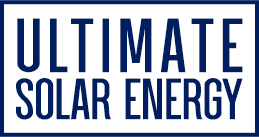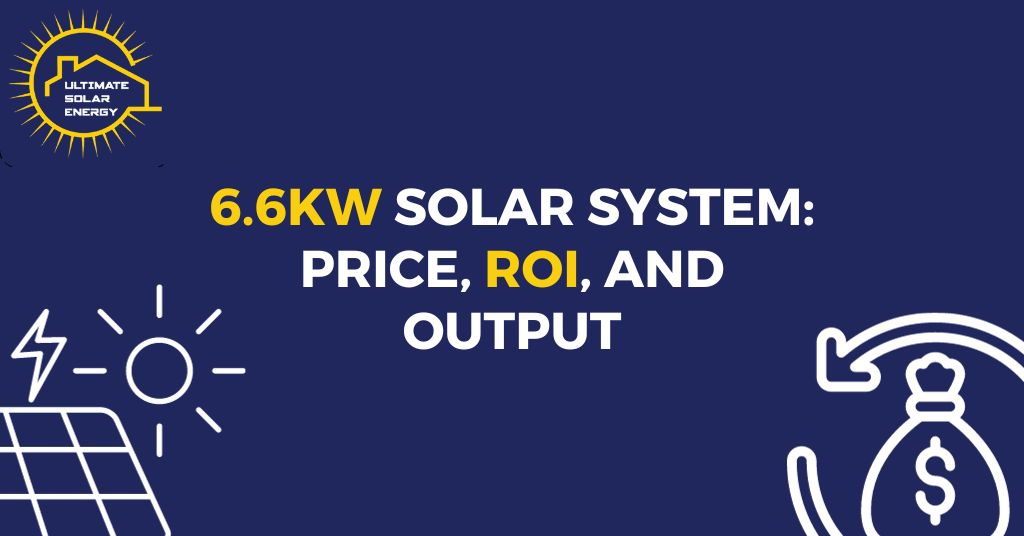6.6kW Solar System: Price, ROI, and Output
[Updated 2024]
6kW solar systems more commonly known as 6.6kW solar systems, are gaining popularity in Australian households due to several factors. These include their cost-effectiveness, generous capacity, and ease of approval for grid connection. In this blog, we will do a comprehensive overview of nearly everything you need to consider when considering a 6kW solar system for your home, covering aspects such as pricing, energy output, and their viability as an investment.
What is the Panel Count & Area Requirement for A 6.6KW Solar System?
When it comes to the number of solar panels, it depends upon the panel power output. For instance, if a panel produces 420 Watts, a 6.6kW solar system, will require 15 – 16 modules. Each panel typically covers an area of 1.7m², so the roof space needed for a 6.6kW system is around 34-38m² — potentially more, depending on your roof layout and whether you opt for tilt frames (which require more spacing than flush-mounted panels on the roof).
Is The 6.6KW System Replacing the 5KW System?
Despite having 6.6kW of solar panels in your system, it’s common for the recommended inverter to be only 5kW. 5kW solar systems are widely favored in Australia for various reasons, including their pre-approval for grid connection across most networks in the country. Consequently, 5kW inverters are more prevalent than their 6kW counterparts in the market. Many 6.6kW solar systems available are, therefore, ‘overclocked’ configurations equipped with a 5kW inverter.
Under the Clean Energy Council guidelines, a 5kW inverter can be overclocked by a maximum of 33% to reach 6.6kW. However, it falls short of reaching 7kW, requiring a larger inverter for such capacity. This setup provides advantages like increased solar energy yields in the early morning and late afternoon, even if the ‘peak’ production is limited to 5kW during the midday period.

What is the Expected Energy Output Of A 6.6KW Solar System?
The actual power generated by a 6.6kW solar power system is 24 Kilowatt-hour but it is significant to understand that it can vary based on several factors, including:
- Location and local climate
- Tilt angle and orientation of the solar panels
- The presence of shading on the panels
- Performance of individual components, primarily the panels and inverter
The solar system’s location is a key factor influencing energy yields, as sunlight exposure directly impacts the system’s output. The table below offers approximate estimates of the energy production from a 6.6kW solar system, relying on data from the Bureau of Meteorology and PVWatts.
It’s important to note that these figures are approximate, and conservative estimates have been employed, assuming a system efficiency rate of 75%. Additionally, these figures represent annual averages; in reality, energy yields will be higher in summer and lower in winter.
ENERGY OUTPUT FROM A 6.6KW SOLAR SYSTEM
|
Capital City |
Approx. Solar Energy Production* (per day) |
|
Adelaide |
24-26 kWh |
|
Brisbane |
25-27 kWh |
|
Canberra |
24-27 kWh |
|
Darwin |
28-30 kWh |
|
Hobart |
19-22 kWh |
|
Melbourne |
21-24 kWh |
|
Perth |
26-28 kWh |
|
Sydney |
22-25 kWh |
*Approximate values; actual energy production may vary based on factors such as location, climate, orientation, shading, and component performance.
6.6KW Solar System With Battery
With the increase in demand, many solar users are evaluating 6.6kw solar systems with battery prices as it is the most suitable solar setup. An increasing number of households are contemplating battery storage when acquiring a solar system. The minimum size we typically suggest for installation, whether you plan to incorporate batteries immediately or in the future, is 5kW. Such a system is generally sufficient to generate surplus energy for storage. However, 6.6kW systems, slightly larger than 5kW, are mostly well-suited for integrating with batteries.
6.6KW Solar System Cost & ROI
As of early 2024, the cost for a professionally installed 6kW solar system using high-quality components typically ranges from $5,200 to $8,700. This estimate includes the applicable solar subsidy.
The key metric for evaluating a solar panel system’s performance, for most consumers, is the payback period. This period represents the number of years it takes for the system to recoup its cost through energy bill savings and feed-in tariff credits.
It’s essential to consider that returns may vary, potentially being more favorable for systems with lower price points or higher levels of solar self-consumption. However, caution is advised in selecting products and companies, as some seemingly attractive deals may be too good to be true.
Why Choose 6.6kW Solar Panels?
Choosing a 6.6kW solar panel system might seem like an arbitrary decision, but it offers excellent value for your investment. If you receive a good feed-in tariff (8 cents per kilowatt-hour or more), this size system will provide a strong return on your investment based on extensive calculations.
Understanding Oversizing Solar Systems
Oversizing refers to installing more solar panel capacity than the inverter capacity. This practice is now quite common, completely safe, and does not damage the inverter. It is highly recommended because Australia’s solar subsidy, often still called the “solar rebate,” is based on the capacity of the panels rather than the inverter size. Therefore, oversizing allows you to maximize the incentive benefits.
Why Not Install Even More Solar Panels?
Although it might be tempting to add more panels, there are limitations to consider. Installation guidelines permit a maximum oversizing of 133% of panel capacity relative to inverter capacity. For a 5kW inverter, this translates to a maximum of 6.65kW of solar panels. While you might not get an exact 6.65kW system, aim to be as close to this limit as possible without exceeding it to stay within the approved oversizing guidelines.
Wrapping Up
The popularity of 6.6kW solar systems in Australia is driven by factors like affordability and grid connection ease. Key considerations include panel count, inverter capacity, and potential battery integration. Geographical location significantly influences energy output, and the payback period is a crucial economic metric. Regional variations underscore the importance of personalized assessments. In deciding on a 6.6kW solar system, careful consideration and staying informed about technological advancements and policies are essential for making a sustainable and cost-effective choice.
At Ultimate Solar Energy, we make your decision-making process so simple. We design customized solutions based on your requirements, using only the most premium products.
Get a Free Quote now!

